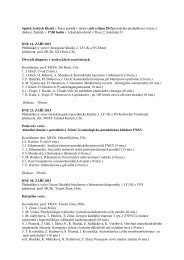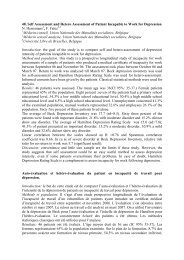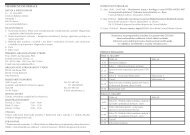ABSTRACTS â ORAL PRESENTATIONS - AMCA, spol. s r.o.
ABSTRACTS â ORAL PRESENTATIONS - AMCA, spol. s r.o.
ABSTRACTS â ORAL PRESENTATIONS - AMCA, spol. s r.o.
You also want an ePaper? Increase the reach of your titles
YUMPU automatically turns print PDFs into web optimized ePapers that Google loves.
egulate expression of different genes. PPAR isoforms (PPAR alpha, beta/delta, gamma)<br />
function through very specific mechanisms. PPAR alpha is predominantly expressed in<br />
liver, heart muscle and brown adipose tissues. It controls fatty acid oxidation and lipid<br />
metabolism by regulation of target genes, like ApoA1, the major apolipoprotein in highdensity<br />
lipoprotein. PPAR alpha agonist turns on ApoA1 expression. PPAR alpha also<br />
controls the expression of lipoprotein lipase, which hydrolyzes triglycerides. PPAR delta<br />
is the second member of this family. It is ubiquitously expressed and has crucial role<br />
in fatty acid oxidation. PPAR gamma is expressed mainly in white and brown adipose<br />
tissues where it functions as central regulator of adipogenesis but it also has important<br />
roles in glucose control and insulin sensitivity by regulation expression of target genes.<br />
In addition, PPAR gamma has been described in many different types of normal and<br />
cancer cells. All PPAR are activated by specific ligands and then they form complex with<br />
RXR alpha. Co-repressors are released and co-activators are recruited to this complex.<br />
Finally, they modify expression of different target genes. The ligand-binding domain for<br />
these receptors is exceptionally large. There are various ligands for the same receptor<br />
that would have different responses with different side effect profiles. Thiazolidinediones<br />
(e.g. rosiglitazone, pioglitazone) are selective PPAR gamma ligands, but their effects in<br />
cancer monotherapy is not very convincing.<br />
Oxaliplatin is the newest platinum derivative used in standard chemotherapy acting<br />
primarily through DNA damage. However, serious side-effects and resistance to<br />
treatment are the main disadvantages of oxaliplatin. Therefore, the new combined<br />
chemotherapeutic strategies are considered with the aim to suppress these unfavorable<br />
effects of platinum-based drugs.<br />
Our study was focused on the combination of oxaliplatin with PPAR gamma ligand<br />
(rosiglitazone; RGZ) in human colon cancer cell lines. The results confirmed that<br />
oxaliplatin and RGZ alone inhibit proliferation of human colon adenocarcinoma cell line<br />
HT-29 in dose - dependent manner. RGZ caused localization of PPAR gamma receptor<br />
into the nucleus after 0.5 - 1 hour treatment. Expression of PPAR gamma was decreased<br />
and localization was translocated perinuclearly after 5 – 48 hour RGZ treatment. Using<br />
PPAR gamma siRNA we confirmed that the decline of PPAR gamma expression is caused<br />
by protein degradation after longer time of RGZ application. This verified that RGZ<br />
decreased either protein expression or nuclear localization in longer time interval. RGZ<br />
alone slightly increased BrdU (5-bromo-2-deoxyuridine) incorporation into the nucleus<br />
after 24 hours. Combination of RGZ with oxaliplatin promoted antiproliferative effects<br />
and cell cycle arrest in the G2/M phase. At the same time we observed enhanced<br />
apoptosis and increased expression of cell cycle related and DNA damage proteins. We<br />
suggest that increased percentage of active BrdU cells induced by RGZ may support the<br />
effects of oxaliplatin.<br />
Because resistance to oxaliplatin is major problem in colorectal cancer treatment we<br />
established cell line derived from HT-29 that acquired resistance to 10mM oxaliplatin<br />
(HT-29 res). We confirmed that in those cells RGZ or oxaliplatin alone did not affect cell<br />
cycle progression. Interestingly, combination of RGZ and oxaliplatin arrested these cells<br />
in G2/M phase, similarly to sensitive cells treated only by oxaliplatin. In addition, single<br />
cell sorting of HT-29 res showed that combination of RGZ with oxaliplatin suppress their<br />
colony formation ability.<br />
124 Analytical Cytometry VII








